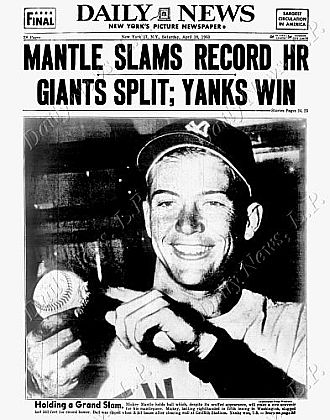
Mickey Mantle shown on the back 'front page' of the New York "Daily News” newspaper, April 18, 1953. Mantle is holding the home run ball he hit out of Washington, D.C.’s Griffith Stadium, estimated to have gone a distance of some 562 feet.
Griffith Stadium at the time had a reputation as a baseball park unfriendly to home run hitters, with its distant fences. The stadium’s dimensions, though varying over the years with changes to its structure, were roughly 400 feet down the left field line, 420 to center, and just under 330 to right. Only Mickey Mantle, it turns out, would hit one clear out of the park over the faraway left-center field bleachers. Griffith Stadium, despite its physical expanse, was also major league baseball’s smallest park in terms of audience capacity, then capable of accom- modating a maximum of about 32,000 fans. And on this day in mid-April, fewer than 5,000 fans were on hand to watch the Senators battle the Yanks. But Mickey Mantle would soon give them something to remember.
Pitching for the Senators that day was Chuck Stobbs, a southpaw. Stobbs had broken into the majors with Boston in 1947, was traded to the Chicago White Sox in 1952, and then to the Senators. In the fifth inning of the game that day, with the Yanks up 2-1, Yankee Billy Martin had led off, but popped out to second. Then Phil Rizzuto came to bat and grounded out to short. Yogi Berra was next, and Dobbs walked him. There were two outs. Then Mantle came to the plate. Mantle, a switch-hitter, batted right against Stobbs.
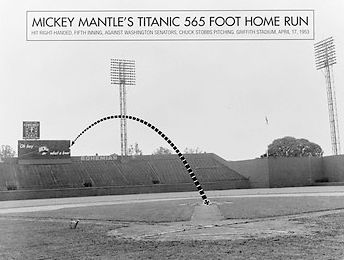
The path of the alleged 565-foot home run that Mickey Mantle was reported to have hit in a game against the Washington Senators on April 17,1953 in Washington, D.C.’s former Griffith Stadium. (Associated Press).
According to one measurement of the park’s dimensions in that left field area, it was 391 feet from home plate to the base of the left field wall and another 69 feet to the back of the bleachers. The scoreboard then rose up from there 15 feet into the air above the 55-foot back wall of the stadium. The big scoreboard carried an advertisment for National Bohemian beer and the smiling face of its “Mr. Boh” logo. Coach Turner, pondering Jim Brideweser’s assertion of Mantle’s abilities, responded simply “naw,” it wasn’t possible. The kid couldn’t do that. “Nobody could do that,” said Turner. And as of that moment, nobody ever had.
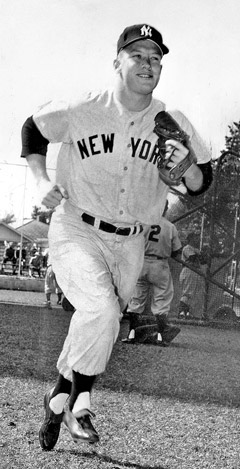
Young Mickey Mantle at spring training, 1954. AP photo.
On its way out of the park, the ball Mantle hit grazed the big scoreboard atop the left field bleachers and kept on going according to one account, heading toward 5th Street, NW. Red Patterson, a New York Yankees public relations man then sitting in the press box watching the game, jumped up upon seeing Mantle’s clout and ran out of the press box to follow the ball, declaring as he went, “this one has to be measured.”
Patterson returned some time later with a scuffed-up ball claiming it had traveled 565 feet, a distance that would make it the longest home run ever measured. Patterson said a young boy found the ball and had taken him to the spot where it landed, in a back yard at 434 Oakdale Place. Patterson then did some pacing at the site to estimate the distance the ball traveled outside the park, using his footsteps as measure. Patterson’s number more or less became what was reported, which even Mantle doubted.
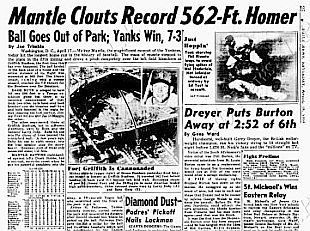
New York Daily News story of April 18, 1953, on the Mantle home run the previous day at Washington’s Griffith Stadium. Story appeared on page 25.
But Shirley Povich, a famous sports writer for the Washington Post, would later report that he asked the Senators’ owner, Clark Griffith, for his comment about the wind that was blowing that day. Griffith’s answer: “I don’t care about that,” he said. “That consarned wind has been blowing for 100 years and nobody else ever hit one out of this ballpark like that.” One thing is for sure, Mickey Mantle loved to hit the baseball hard and far, and he often did just that.Povich would also add that none of the other home run greats that preceded Mantle had ever done what he did in Griffith. “Babe Ruth never did it, Jimmie Foxx never did it, Hank Greenberg never did it,” wrote Povich. Only Mantle.
Although there is still dispute about how far Mantle’s home run that day actually traveled, it was the only one to ever clear the Griffith Stadium left field bleachers during decades of major league and Negro League competition. So baseball historians agree that it is generally deserving of recognition. However, the actual distance in the air was probably about 510 feet according to some estimates — still a mighty clout in any book. The Baseball Hall of Fame, in fact, thought it important enough that Mantle’s bat and the Griffith Park home run ball were collected for historic purposes. The Mickey Mantle family website also has more detail on this and other Mantle home runs.
Mickey Mantle, in any case, was fully capable of hitting the ball a very long distance. Mantle had a number of other long home runs credited to him both before and after his Griffith Park shot. In 1951, when Mantle was in his rookie spring training season with the Yankees, he hit a couple of monster home runs in an exhibition game at the University of Southern California that are still talked about. Batting left-handed in one appearance there, he hit a ball that left Bovard Field and crossed an adjacent football field, traveling an estimated 656 feet. Some cite it as the longest home run in baseball history. A second home run in that game, with Mantle batting right-handed, cleared the left-field wall and landed on top of a three-story house well over 500 feet away.
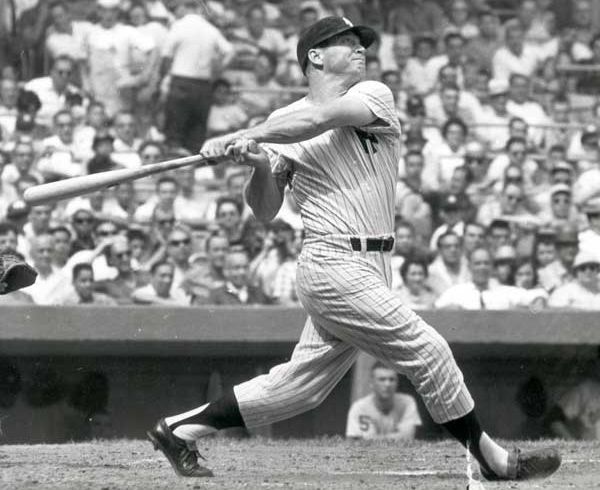 Mickey Mantle’s powerful swing from the left side of the plate, September 3, 1961, hitting his 49th home run during the fabled race with Roger Maris, who went on to break Babe Ruth’s record that year with 61. |
Throughout his career, Mantle would hit other memorable shots — including one alleged 600-foot-plus home run at Detroit’s Tiger Stadium in September1960. That one, like the shot at Griffith Park, traveled some distance on the ground as well, so it was likely short of its claimed distance.“Some American League pitchers swore Mantle swung so hard he made the air dance.” — Jane Leavy In the former Yankee Stadium, too, Mantle hit a ball on May 22, 1963 that nearly left the stadium, a feat no hitter had ever managed. The ball struck the facade on the right-field roof approximately 370 feet from home plate and 115 feet above field level. Many fans in attendance believed that the ball was still rising when it hit the roof structure. Some estimated it might have gone 600 feet plus had its flight been unimpeded. But experts say the flight of the ball observed by fans that day was an optical illusion and that the ball Mantle hit was already on its way down when it hit the roof, though still a singular accomplishment and memorable home run.
Mickey Mantle was a much loved baseball player, typically humble about his hitting abilities and not the boastful type when it came to claiming records or distance. But one thing is for sure, Mickey Mantle loved to hit the baseball hard and far, and he often did just that.
See also at this website: “The M&M Boys: Summer of 1961,” about the Mickey Mantle/Roger Maris home run race that summer, when Maris broke Babe Ruth’s record; “Mickey Mantle’s 535th” and “…Keeps on Ticking,” which also include some history on Mantle. Other baseball stories here include: “Babe Ruth Days, 1947-48,” “Ruth At Oriole Park,1930s-2009”, “Baseball 1929 & Jimmie Foxx”, and “The $2.8 Milliion Baseball Card”. Thanks for visiting — and if you like what you find here, please make a donation to help support the research and writing at this website. Thank you. — Jack Doyle
|
Please Support Thank You |
_________________________________
Date Posted: 12 February 2010
Last Update: 2 December 2020
Comments to: jdoyle@pophistorydig.com
Article Citation:
Jack Doyle, “Mantle’s Griffith Shot, April 1953,”
PopHistoryDig.com, February 12, 2010.
_________________________________
Sources, Links & Additional Information
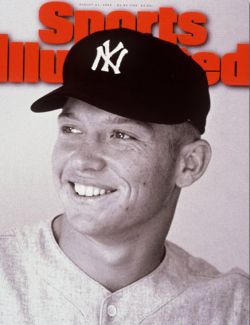 Young Mickey Mantle shown on a later edition “Sports Illustrated” cover, August 21, 1995, shortly after Mantle’s passing. |
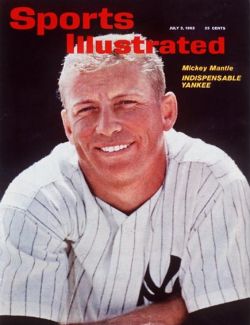 Sports Illustrated cover story, July 2, 1962, "Mickey Mantle, The Indispensable Yankee." |
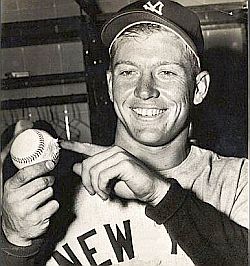 Mickey Mantle holding the ball he hit out of Griffith Park, April 17, 1953. |
Maury Allen, Memories of the Mick, Taylor Pub- lishing: Dallas, Texas, 1997, pp. 54-57.
Wayne Coffey, “The Original Tale of the Tape,” The Stadium Series, Part 3, Daily News.com, 2007, p. 1.
“Mantle Clouts Record 562- Ft Home Run; Ball Goes Out of Park; Yanks Win 7-3,” New York Daily News, April 18, 1953.
“Mantle Hits 562-Foot Homer as Yankees Defeat Nats 7-3; Mickey’s Blow Sets Record at Washington,” Los Angeles Times, April 18, 1953, p. B-1.
Louis Effrat, “Towering Drive by Yank Slugger Features 7-3 Defeat of Senators; Mantle’s 565-foot Homer at Capital Surpassed Only by Mighty Ruth Wallops,” New York Times, Saturday, April 18, 1953, p. 12.
Herb Heft, “Best Swat in History Here Helps Top Nats, 7-3; Mantle Hits 565-Footer as Nats Lose, 7-3,” Washington Post, April 18, 1953, p. 13.
Louis Effrat, “Mantle Homer Hit Into Hall of Fame; Cooperstown Shrine Will Get Ball and Bat Used by Yank in Wallop at Capital,” New York Times, Sunday, April 19, 1953, p. S-1.
“Joe Dimaggio Hails Mantle,” Los Angeles Times, April 20, 1953, p. C-1.
“No Wind, Declares Judge, Helped Mantle Homer,” New York Times, Tuesday, April 21, 1953, Sports, p. 34.
Shirley Povich, “To Whom It May Concern,” Washington Post, April 26, 1953, p. C-1.
Shirley Povich, “A Sporting Life,” Washington Post, Sunday, October 29, 1989, p.W-22.
Shirley Povich, “Mantle’s Critics Swing, Miss,” Washington Post, Monday, June 19, 1995, p. C-1.
Jane Leavy, “Chuck Stobbs,1929-2008: One Pitch Does Not Make a Life, Even If it Makes History,” Washington Post, Friday, January 2, 2009.
David Halberstam, October 1964, Villard Books, New York, 1994, 380pp.
“Longest Home Run Ever Hit,” Baseball Almanac .com.
Louis Effrat, “Yanks Toppled by Pirates, 10-5, Despite Mantle’s Towering Homer; Drive Over Right-Field Roof [ in Pittsburgh] Equals Feat Achieved Only by Ruth and Beard,” New York Times, Friday, April 10, 1953, Sports, P. 27.
Joseph M. Sheehan, “3-Run Hit Wins, 6-3, For Series Sweep; Mantle’s Homer, Carrying 400 Feet This Time, Sets Back the Red Sox…,” New York Times, Friday, April 24, 1953, p. 31, 982 words
“Mickey Mantle Blasts 480 Foot Homer in St. Louis,” Washington Post, April 30, 1953, Sports, p. 25.
“Mickey Mantle & Sports Illustrated covers,” SportsIllustrated.CNN.com.
“Mickey’s Historic Homer On Trial!,” Mickey Mantle.com.
Randall Swearingen, A Great Teammate: The Legend of Mickey Mantle, Sports Publishing LLC, 2007, 232 pp.
____________________________________